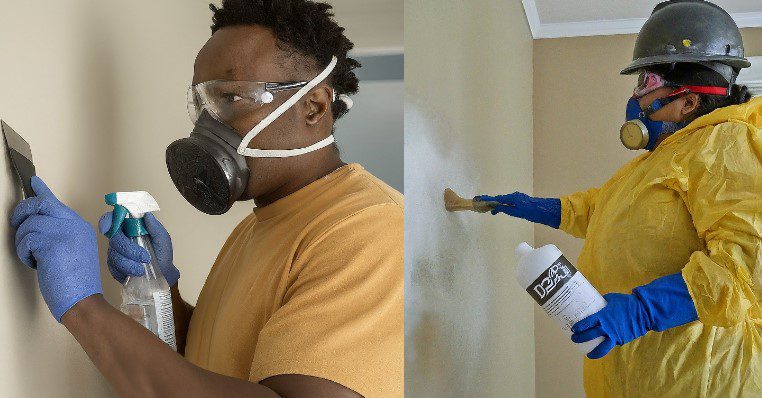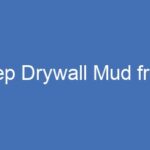Drywall mud is a type of joint compound that is used to fill gaps and seams in drywall. It is a porous material that can absorb moisture, which can create the perfect environment for mold growth. However, if not handled and stored properly, it can be susceptible to mold growth. Mold can be a serious health hazard and can also damage the structural integrity of the drywall. Therefore, it is important to take steps to prevent mold growth on drywall mud.
Understanding the Causes
Drywall mud is prone to molding due to its composition and the environmental conditions it is exposed to. The moisture content in the air and the humidity levels play a significant role in the mold growth on drywall mud. Individuals in more humid climates tend to encounter mold growth on drywall mud more frequently, indicating that high humidity can contribute to this issue.
Additionally, exposure to moisture and air can lead to mold development on drywall mud, especially if it is not stored in optimal conditions. The presence of mold spores in the air can also contribute to the molding of drywall mud. These factors create an environment conducive to mold growth, making it essential to understand and address them to prevent molding of drywall mud.
What are the signs of contamination in drywall mud?
The signs of contamination in drywall mud include:
- Visual Inspection: Mold, mildew, or unusual discoloration on the surface of the drywall mud can indicate contamination. If any of these signs are present, the mud should be discarded immediately to prevent compromising the quality of other supplies.
- Strange Odors: Unusual or pungent odors emanating from the drywall mud can be an indication of contamination. If the mud emits a foul or moldy smell, it should be discarded to avoid potential health hazards and compromised quality.
- Unusual Texture: Contaminated drywall mud may have an irregular or lumpy texture, indicating the presence of foreign particles or mold growth. Any deviation from the normal consistency should be considered a sign of contamination.
Regularly inspecting containers of drywall mud for these signs of contamination is essential to ensure the quality and safety of the material for use in construction or renovation projects.
What are the common types of contamination found in drywall mud?
Contamination in drywall mud can come from various sources, including dust, dirt, and other debris that can find their way into the container when left uncovered or stored in unsanitary conditions. Additionally, drywall mud can contain hazardous substances such as silica, asbestos, and sulfur compounds, which can pose serious health risks to individuals handling the material.
Silica dust released when cutting and sanding drywall can cause upper respiratory problems similar to asthma, while asbestos in older drywall mud can cause health problems such as lung cancer.
Furthermore, some drywall imported from China between 2001 and 2007 contains sulfur compounds that emit toxic gases, posing a significant health risk to workers. Therefore, the common types of contamination found in drywall mud encompass dust, dirt, hazardous substances such as silica and asbestos, and toxic chemicals emitted by sulfur compounds.
Prevention Methods
To prevent mold growth on drywall mud, it is crucial to minimize the risk of moisture and humidity. This can be achieved by implementing proper storage techniques and maintaining optimal humidity levels in the working area. One suggestion is to cover the drywall mud with a thin layer of water and a small amount of bleach to prevent mold growth.
Another recommendation is by using Microban, a mold inhibitor, to keep the drywall mud fresh for months. Furthermore, it is important to keep the drywall mud covered and avoid storing it in cold, damp areas to prevent mold growth. These measures can help create an environment less conducive to mold development, thereby addressing the factors that contribute to mold growth on drywall mud.
There are a few things you can do to prevent drywall mud from molding:
- Use a mold-resistant drywall mud.
- Apply the drywall mud in a thin layer.
- Allow the drywall mud to dry completely before applying a sealant.
- Keep the area where the drywall mud is being applied dry and well-ventilated.
By following these tips, you can help prevent drywall mud from molding and keep your home mold-free.



Dealing with Mold on Drywall
When mold develops on drywall mud, it is essential to take prompt and careful steps to address the issue and prevent the spread of mold. The first step in dealing with mold on drywall is to seal the affected area to prevent the spread of mold spores. This can be achieved by using plastic sheeting and tape to isolate the contaminated area.
Additionally, it is important to turn off any fans or air conditioning to prevent the spread of mold spores during the removal process.
Safe removal and remediation procedures are crucial to effectively address mold on drywall. The surface mold should be carefully removed using a HEPA-equipped shop vacuum and a medium-bristled cleaning brush. It is important to break up the spores and remove as many as possible to ensure thorough cleaning. After removing the surface mold, the affected area should be treated with a cleaning solution to kill the remaining mold. It is also recommended to use a box fan to ventilate the area and aid in the drying process.
Guidance on whether to salvage the affected drywall or replace it is an important consideration. If the drywall is soft to the touch or if the moisture and mold have compromised its structural integrity, it is advisable to remove the affected drywall, kill the mold on the framing underneath, allow it to dry, and start fresh. This decision is crucial to ensure the safety and quality of the finished work, as compromised drywall can lead to further mold growth and structural issues.
When dealing with mold on drywall, it is important to follow careful removal and remediation procedures to prevent the spread of mold spores. Additionally, the decision to salvage or replace the affected drywall should be based on the extent of the damage and the structural integrity of the material. By following these steps, individuals can effectively address mold on drywall and ensure the safety and quality of their construction or renovation projects.
Tips for Cleaning Drywall Mud Mold
If you find that you have drywall mud mold, there are a few things you can do to clean it.
First, you will need to remove the drywall mud that is infected with mold. You can do this by scraping it off with a putty knife or by using a wire brush. Be sure to wear gloves and a mask to protect yourself from the mold spores.
Once you have removed the infected drywall mud, you will need to clean the area with a bleach solution. Mix one part bleach to three parts water and apply it to the area with a sponge or cloth. Allow the bleach solution to sit for at least 10 minutes, then rinse it off with clean water.
You may need to repeat this process several times to completely remove the mold. Be sure to allow the area to dry completely before repainting or applying new drywall mud.
Here are a few tips for preventing drywall mud mold in the future:
- Use a mold-resistant drywall mud.
- Apply a sealant to the drywall mud after it has dried.
- Keep the area around the drywall mud dry and well-ventilated.
- Clean up any spills or leaks immediately.
Conclusion
In conclusion, the susceptibility of drywall mud to mold growth is influenced by factors such as moisture, humidity, and the presence of mold spores in the air. By understanding these causes, individuals can take proactive measures to prevent mold growth on drywall mud. Implementing proper storage techniques, minimizing moisture and humidity, and using mold inhibitors are effective ways to address these causes and keep drywall mud from molding.
Citations:
[1] https://storables.com/articles/how-to-store-drywall-mud/
[2] https://int-enviroguard.com/blog/employing-best-safety-practices-can-avoid-hazards-associated-with-drywall-installation/
[3] https://www.worksafebc.com/en/health-safety/hazards-exposures/drywall
[4] https://www.poison.org/articles/when-is-drywall-a-problem-172
[5] https://inspectapedia.com/hazmat/Asbestos_in_Drywall.php
tag: # How to Keep Drywall Mud from Molding







